Überclok Ion: Midrange Overclocking, with a Warranty
by Matt Campbell on February 12, 2008 4:10 AM EST- Posted in
- Systems
Overclocking (higher) and SLI
We've seen what the Ion can do as configured out of the box, but what about pushing it even farther? Where would upgrades be most effective? To answer these questions, we examined two possible paths to increasing performance: a faster processor and the addition of another 8800 GT for SLI.
Overclocking (higher)
Ok, so we voided the warranty - but with the Tuniq, airflow, and thermal protection, odds are extremely unlikely that a little experimentation will hurt. We opted to stay conservative, pushing the E4500 up another 300 MHz to 3.3GHz. Does this provide any gains at all?
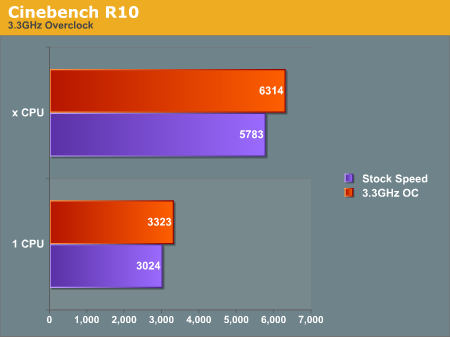
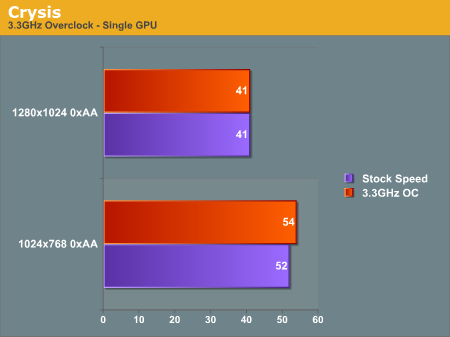
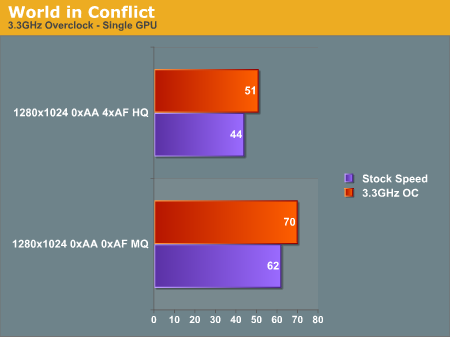
What do the above tell us? In our Cinebench CPU benchmark, a 10% increase in clock speed gives us about a 10% increase in score. With a control test established, we move on to gaming performance. At 1280x1024, we see large gains in performance in World in Conflict. Clearly, a faster CPU will aid greatly in this strategy game. In Crysis however, we see a clear hinge point, with a noticeable increase at 1024x768 and almost zero change at 1280x1024. As we found in our Shuttle review, the 8800 GT becomes completely GPU-bound at resolutions of 1280x1024 and higher.
8800 GT SLI
Now that we've looked at overclocking, what kind of a performance increase would we obtain if opted for another 8800 GT instead? We lowered the clocks of the Ion system back down to 3.0 GHz ("stock") and added another 8800 GT. The expandability of the system is really what facilitated this test; because the motherboard is SLI and the power supply is readily able to handle another video card (with an included PCIe power cable), installation was a 5-minute affair. What kind of numbers do we see now?
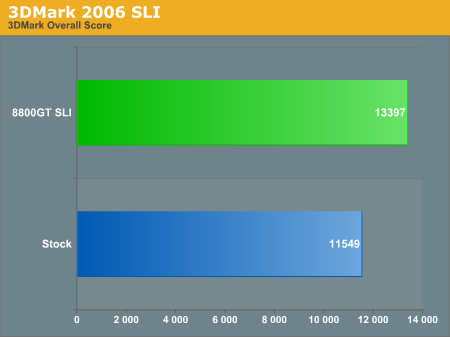
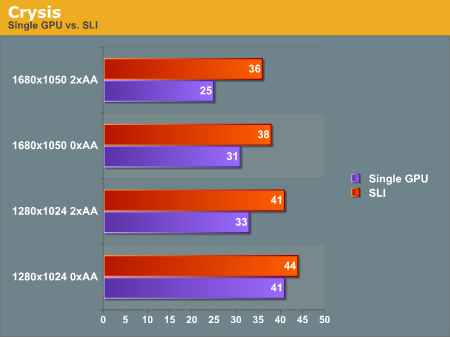
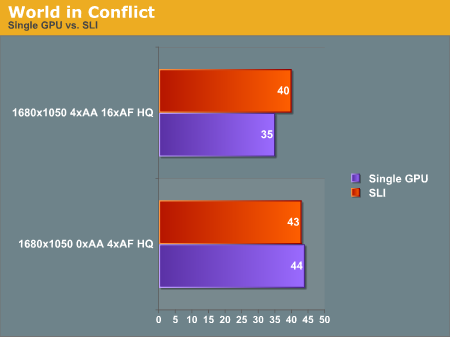
The synthetic benchmark shows a 16% performance gain at 1280x1024. Is this indicative of what we see in games? Not really - we have different constraints coming into play. World in Conflict is CPU hungry, as we showed in the overclocking section, and no increase at all is seen at up to 1680x1050 without antialiasing. Once we enable 4xAA, we do indeed see an increase, but it's still not tremendous. Crysis is a completely different story; while a CPU increase had little effect at 1280x1024 and above, the SLI configuration yields gains of up to 44%.
Which upgrade makes more sense? The above graphs are just a snapshot of performance, but depending on your monitor (i.e. the resolution you play games at) and the games you play, either upgrade could provide a reasonable performance boost. A CPU upgrade will help in many strategy games that tend to tax that area more, as well as Flight Simulator X; an E8400 at 4.0 GHz is an available upgrade on the Ion for $160, vs. a $290 upgrade for dual 8800 GTs, also making it an attractive choice cost-wise.
Crysis is somewhat unique in how much it relies upon a blazing fast graphics subsystem. If you intend to play Crysis at higher detail settings, then clearly you'll want to pony up for more GPU power as a CPU upgrade buys you nothing at higher resolutions. However, other games also demand a fast graphics subsystem, and more will likely come out in the near future. Obviously, if you want better performance in all situations, a faster CPU and a second GPU is the way to go, though at $400+ that's certainly not a cheap upgrade to make. One final thought is that you can always add a second GPU later and lose nothing; if you decide to upgrade CPUs down the road, you'll end up with a spare CPU. Thus, we'd recommend spending a bit more in the processor area if you can manage it.










38 Comments
View All Comments
DrMrLordX - Friday, February 15, 2008 - link
This is a business model I've often wondered about myself. Considering how many technical, legal, and customer issues could be involved with building and selling systems like this, it seems like a risky gambit. It was only a matter of time before all the OC-friendly hardware on the market finally found its way into an OCed system that didn't cost an arm and a leg.I really hope it does work out for you guys.
cooklaw - Thursday, February 14, 2008 - link
The hardware this thing has at an amazing price point (even for Dell) will be tough to compete with. Check out their presale special. Full details will be up soon.dell.com/xps630
Uberclok - Thursday, February 14, 2008 - link
Interesting. What is the price, and what does it include?IdaGno - Thursday, February 14, 2008 - link
Onboard sound? W's Vista, probably may as well, but if XP, then I'd want a sound card Even an entry level discrete sound card soultion is preferred to onboard. Currently running thru SS2 again & the difference w/EAX enabled is profound.http://techreport.com/articles.x/11171/1">http://techreport.com/articles.x/11171/1
initialised - Wednesday, February 13, 2008 - link
Overclocking settings:1.5V Vcore
1.4V Vfsb
273MHz FSB
Excessive voltage for such a conservative overclock.
3.2GHz on an E4500 typically requires 1.4V Vcore at 400x8.
I have 3.4GHz stable at 425x8 on 1.4375.
I guess they do it this way to reduce the impact of dust maggots during the 3-year RTB period.
Some good ideas there, despite the conservative settings, I might look into implementing some of them.
gsubrec - Wednesday, February 13, 2008 - link
1. The heatsink is a 800g Tunic, which has special packing to prevent falling off during shipping. Why dont they use Thermalright Ultima-90, which is only 460g, and per the Anandtech testing performs just as good as the Tunic2. The only difference between the Ion and the Reactor series is that the website claims that the Ion videocard cannot handle > 22 inch monitors. The website seems to be incorrect, the Ion has the 8800GT which has 512MB, which is enough for 2500x1600 , 30 inch monitor
Uberclok - Thursday, February 14, 2008 - link
Good points:1. We'll take a look at the Ultima, it might be a good fit for us.
2. The Ion is -recommended- for 22 inch monitors or lower because the 8800 GT/GTS cards can play most new games at high settings with 4x AA up to about 1680x1050. The cards are capable of decent frame rates on some games at higher resolutions, but we want to encourage our customers to consider the GTX/Ultra-equipped Reactor if they intend to play at 1920x1200 or higher, and that usually equates to 24" monitors and up.
- Thomas Glen
Uberclok
(877) 211-4235
thomas.glen@uberclok.com
Radagastmod - Wednesday, February 13, 2008 - link
Looks really good to me. I would recommend these to someone not comfortable with building their own machine.I especially like the binder with all the manuals in it, nice touch.
Shadowmaster625 - Wednesday, February 13, 2008 - link
E4500 = $120GA-P35-DS3L= $90
2G or RAM = $50
8800GT = $240
320gig HDD = $70
Case, power supply, dvd = $120
total < $700
Price this company charges to overclock an E4500 to 3GHz? AN ARM AND A FRIGGIN LEG. A monkey can overclock an E4500 to 3 GHz. wtf are you wasting your time promoting this scam company? For the money they charge you could buy TWO of these systems. Good gawd...
Uberclok - Wednesday, February 13, 2008 - link
We're not running any scam, I assure you. Our components are chosen because they are high quality, offer solid features, and are reasonably priced. Allow me to respond to the prices you've offered up:E4500 = $120
That's true, although I take issue with your claim that a monkey could overclock it to 3.0GHz. Our monkey could only get a stable overclock at 2.8GHz, at which point he threw his own feces into the case and shorted everything out.
GA-P35-DS3L= $90
This is a fine motherboard, (we particularly like the BIOS settings profiles) but it doesn't suit our needs. It has only one PCIe x16 slot, and cannot support SLI. While we do sell single-card systems, we want our customers to be able to drop in a second card later without upgrading the motherboard or power supply. The 680i SLI boards we use also offer two additional SATA connectors, allowing us to offer up to four hard drives in addition to two SATA-based optical drives. (Avoiding IDE devices helps us keep the interior clean.) We have also built RAID-based solutions for some of our customers, which this board doesn't do.
There are other advantages as well - 6 external USB ports instead of four, IEEE-1394, a POST code display (which helps us troubleshoot over the phone) an extra ethernet port (which I admit is frivolous, but nice) and a third PCIe slot running at x8, which is intended for a physics card. (And that might actually end up meaning something depending on what nVidia's going to do with the new toy it bought itself.) We use EVGA's 680i, which retails for $210.
2G of RAM = $50
RAM is quite affordable these days, but the price still varies according to brand, quality, speed, and timings. As with all our components, we aim for the point on the price-performance curve just before it turns sharply upwards, so our customers are getting high-quality parts but at a reasonable cost. We also tend to pass on technology which doesn't improve gaming performance, since that's the main point of what we build.
Our testing has shown us that DDR2-800 with 4-4-4-12 timings is our best bet right now for the Ion. (Moving to DDR2-1066 adds a slight performance increase in some games at a bit of an added cost, so we use that for the Reactor model we sell.) We like Corsair's reputation and history of producing high quality memory, and the price for their 2GB kit of DDR2-800 with 4-4-4-12 timings is about $70. Corsair loves to offer rebates, so it's not unusual to be able to get them for a final price even lower than the $50 you mention, but as a system builder, we don't get to take advantage of rebate offers.
8800GT = $240
The cards we use usually retail for $20 more than that, but you're pretty close.
320gig HDD = $70
The 500GB drive we use now is Seagate's ST3500320AS - it retails for $120
Case, power supply, dvd = $120
You could use a cheap PSU, but you're asking for trouble. Investing in a high-quality PSU was one of the earliest lessons we learned. It keeps our PCs running smoothly and protects the components from damage. We also like to stick to nVidia's list of SLI certified PSUs for whatever card is in the PC. (Or Crossfire-certified, if we go back to ATI.) The Thermaltake Toughpower 650 is an excellent choice with room to grow, and retails for $170.
The Antec 900 case is part of what allows us to overclock the memory, CPU, motherboard, and video cards on air cooling, so although it retails for $100 or so, it saves us from having to install a pricey liquid cooling solution. The DVD-R and DVD-ROM drives we offer are quite affordable ($34 for the DVD-R with LightScribe and dual-layer support, and $18 for the DVD-ROM.)
The Tuniq Tower 120 CPU cooler, operating system, internal cables, keyboard, mouse, box, labels, binder, zip ties, and shipping costs add up to another $250 or so. We also include a media reader/floppy drive whiich sells for $25-$45 depending on availability.
Finally, you might want to consider the additional expenses any business like ours incurs, such as rent, heat, electricity, salaries, insurance, accounting, ding-dongs, R&D, review units, PR, advertising, web design and hosting, market research, and mob hit contracts when FedEx shrugs its mighty shoulders at our damage claim forms. I very much doubt a business could survive selling PCs like the one you describe.
- Thomas Glen
Uberclok
(877) 211-4235
thomas.glen@uberclok.com